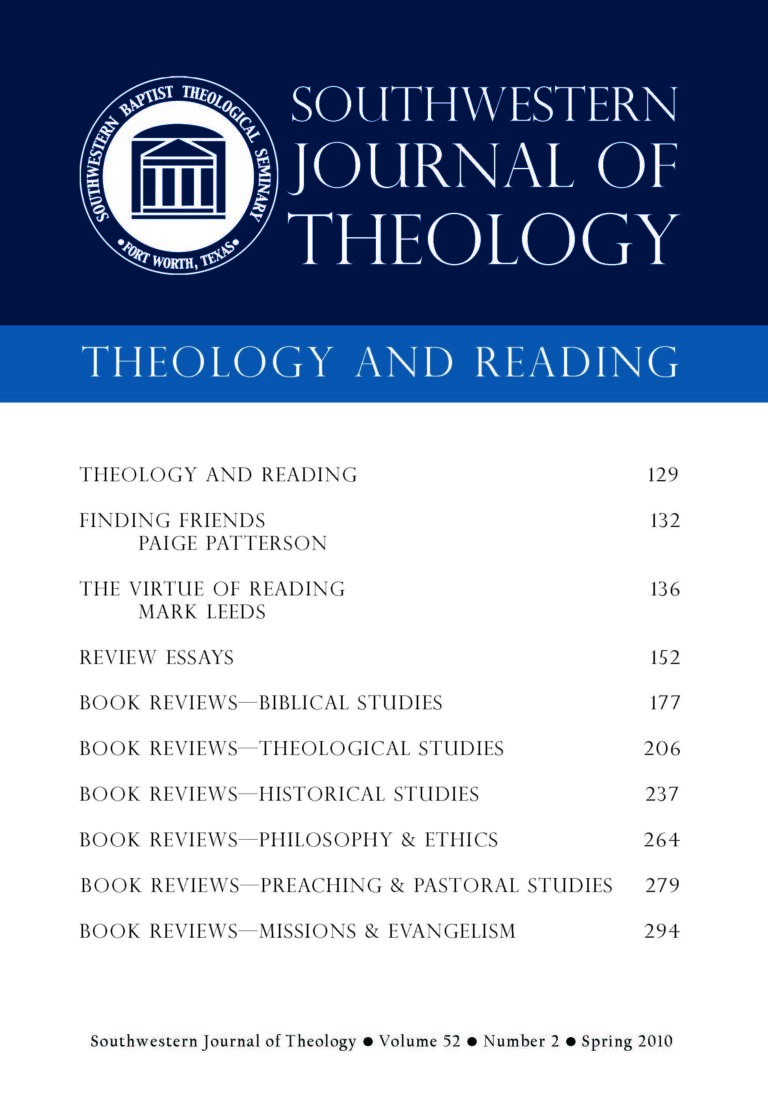
Theology and Reading
Southwestern Journal of Theology
Volume 52, No. 2 – Spring 2010
Managing Editor: Malcolm B. Yarnell III
Edited by Kevin J. Vanhoozer, et al. Grand Rapids: Baker Academic, 2008. 270 pages. Softcover, $13.59.
In 2005 Baker Academic published Dictionary for Theological Interpretation of the Bible (DTIB), a hefty one-volume work (896 pages) comprised of more than two hundred and eighty articles related to biblical interpretation and theology edited by Kevin J. Vanhoozer, Craig G. Bartholomew, Daniel J. Treier, and N.T. Wright. The intent of the book is to assess current interpretative approaches to Scripture with the aim of employing them in a theologically responsible manner for the benefit of the church. Contributors come from different Christian denominations and perspectives. However, the majority of entries fit comfortably within a broadly defined evangelicalism. Articles in DTIB may be placed into four basic categories: texts (e.g., survey of Bible books), hermeneutics, interpreters and interpretive communities, and doctrines and themes.
From DTIB came two works, Theological Interpretation of the New Testament (TINT) and Theological Interpretation of the Old Testament (TIOT), both published in 2008. In these later much shorter volumes one finds articles originally presented in DTIB that pertain primarily to the Old and New Testament writings. This review examines TINT.
TINT contains an introductory essay by Vanhoozer that sets the stage for the book-by-book survey of the New Testament writings. Vanhoozer addresses the question, “What is theological interpretation of the Bible?” In his view, approaches that impose a particular theological system or theory of interpretation on the text, or that limit interpretation to a specific critical model (e.g., literary criticism), fail to provide a true theological interpretation of the Scriptures. Instead, Vanhoozer affirms the following principles: 1) theological interpretation is a joint enterprise of multiple disciplines, not just biblical scholarship; 2) theological interpretation should be marked by an overarching concern to understand the character and work of God; and finally, 3) theological interpretation must allow for differing approaches. Vanhoozer openly acknowledges that at the present time scholars are still in the initial stages of finding a satisfactory theological interpretation of Scripture.
Vanhoozer’s essay is helpful in that it reminds interpreters of the need to explore Scripture on its own terms rather than simply imposing one’s theological tradition on the text. Also, he rightly stresses the importance of studying the Bible with the goal of gaining a better understanding of knowing and loving God. Vanhoozer provides an insightful essay that merits thoughtful reflection.
In the essays that follow, scholars from institutions primarily in the United States and Great Britain survey the New Testament writings. Contributors were asked to give special attention to a biblical work’s history of interpretation, theological message, relation to the larger canon, and unique contribution to the church. Those who carry out their assignment especially well include: Steve Walton, David Garland, N.T. Wright, Charles Wanamaker, I. Howard Marshall, and Daniel Streett. Walton’s discussion of the message of Acts is enlightening in that he rightly draws attention to Luke’s portrayal of God as one who intervenes on behalf of his people at crucial points. Garland, who has written a fine commentary on 1 Corinthians for the BECNT series, provides a concise yet theologically rich summary of the letter’s contents. Wright’s survey of Philippians draws attention to a key theme of the letter: how believers are to live within their surrounding pagan society. Along with discussing this motif, the author identifies additional relevant themes. From a literary standpoint his essay stands as a model of succinctness. Wanamaker’s summary of the theological themes found in 1 and 2 Thessalonians is useful, as is his brief survey of the history of interpretation of the letters. Marshall’s discussion of the Pastorals is worth consulting due to the fact that he astutely identifies the most relevant issues related to interpretation. Finally, Streett should be commended for admonishing the reader to examine Philemon in its first-century historical context, rather than (as is often the case) from a postEnlightenment perspective.
TINT is a helpful resource for anyone seeking a better understanding of the New Testament writings. Along with supplying a concise summary of the dominant theological themes, TINT provides beneficial overviews of the history of interpretation that assist in identifying the most crucial interpretive issues related to each book. Nevertheless, it would appear wiser to purchase the larger volume (DTIB) rather than TINT or TIOT, as the original writing contains additional articles that inform the interpreter in his study of Scripture.





